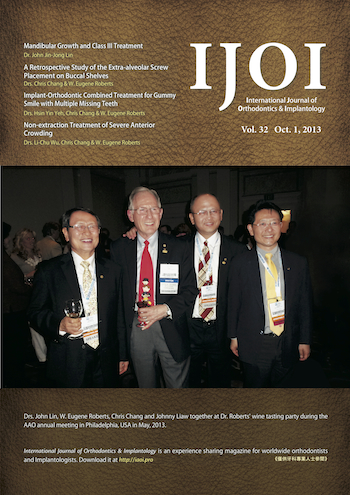IJOI Vol. 32

Mandibular Growth and Class III Treatment
Lin JJ
Questionable Concepts of the Developing Class III
Most orthodontics literature advocates early treatment for anterior crossbite,1-4 largely based on the hypothesis that a persistent anterior crossbite favors excessive growth of the mandible, and inadequate growth of the maxilla. This concept is predicated on the belief that a proper vertical overlap of the maxillary incisors is necessary to restrict mandibular and enhance maxillary growth. [… read more]
Implant-Orthodontic Combined Treatment for Gummy Smile with Multiple Missing Teeth
Yeh HY, Chang CH, Roberts WE
Abstract
This case report describes the interdisciplinary treatment of a 29-year-old woman presenting with a chief complaint of excessive gingival display (“gummy smile”). Her acquired, asymmetric right Class II malocclusion was complicated by three missing posterior teeth in the maxillary arch. Orthodontics was indicated to correct smile esthetics, reduce lip protrusion and align the dentition before utilizing prosthetics to improve the occlusal function. Mandibular second premolars were extracted to retract the lower incisors. The maxillary dentition was also retracted as well as intruded with miniscrews to close the missing molar spaces and correct the gummy smile. The maxillary right first premolar space was prepared for an implant-supported crown. A marked improvement in smile esthetics and occlusal function was achieved. (Int J Orthod Implantol 2013;32:16-32)
Non-extraction Treatment of Severe Anterior Crowding
Wu LC, Chang CH, Roberts WE
History and Etiology
A 21-year-10-month old female presented for orthodontic consultation. Her chief complaint was the irregularity of her teeth (Figs. 1-3). There was no contributing medical or dental history. Her oral hygiene was good, and temporomandibular function was within normal limits (WNL). (Int J Orthod Implantol 2013;32:34-46)
Class I Crowding with Canine Transposition and Midline Deviation
Wei MW, Chang CH, Roberts WE
History and Etiology
A 18-year-11-month-old male presented with a chief complaint of “crocked teeth,” an apparent reference to his asymmetric anterior malocclusion (Figs. 1-3). There was no other contributory medical or dental history. Clinical exam revealed transposition of the permanent right maxillary canine and adjacent premolar. In addition, generalized crowding was noted in both arches (Fig. 2). Extraction of all four first permanent premolars was indicated, to relieve crowding in both arches and correct the canine-premolar transposition. The patient was treated to an acceptable result as documented in Figs. 4-9. Detailed diagnosis, treatment procedures and recommended follow-up will be discussed below. (Int J Orthod Implantol 2013;32:48-61)
Compromised Treatment for an Asymmetric Class II/III Mutilated Malocclusion with Facial Asymmetry
Chang HW, Chang CH, Roberts WE
History and Etiology
A 23-year-6-month-old male presented for orthodontic consultation with chief complaints of irregular dentition, mandible shift and facial asymmetry (Fig. 1). There was no contributory medical or dental history. A clinical exam revealed that the permanent (Int J Orthod Implantol 2013;32:64-77) [… read more]
A Retrospective Study of the Extra-alveolar Screw Placement on Buccal Shelves
Chang CH, Roberts WE
ABSTRACT
Background:Previous studies on inter-radicular screw insertion have shown that there was a significantly higher failure rate for screws inserted through moveable mucosa compared to attached gingiva. Furthermore, there are no reports about the stability of the extra-alveolar screw insertion into the buccal shelf of the mandible. This is an important area of research because extra-alveolar miniscrews placed in the buccal shelf are effective anchorage, for retracting the entire lower dentition to correct Class III malocclusion. It is important to understand the success rate and stability for buccal shelf miniscrews placed in different locations. (Int J Orthod Implantol 2013;32:80-89) [… read more]
Case Report: Surgery-First Approach Combining with CDG® for Class II Patients
ABSTRACT
This article presents an interdisciplinary treatment approach for a 20-year-old female patient presenting with: (1) a convex profile, (2) and skeletal Class II malocclusion due to inferior mandibular retrognathism, (3) Retrogenia and (4) Amelogenesis imperfecta. Surgery was applied before orthodontics. A new device, Castellanos Direct Guides (CDG®), was used to ensure correct occlusal fixation during the surgery. The treatment time was significantly reduced to 8 months and the outcome was satisfactory according to the treatment plan. (Int J Orthod Implantol 2013;32:100-106)